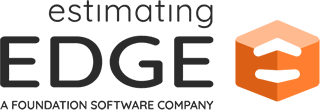 Estimating Edge’s team of experienced construction professionals and software engineers have developed the industry’s smartest takeoff and estimating software solutions for competitive estimates.
Estimating Edge’s team of experienced construction professionals and software engineers have developed the industry’s smartest takeoff and estimating software solutions for competitive estimates.
Don’t just estimate faster. Estimate better.®
- /
- /
- /
Delete Databases
How To Delete Databases
Overview:
The EDGE Estimating system may contain a dozen or more databases depending on how your system or systems are configured. Lines cannot be deleted hap hazardously from a database. The databases are interconnected as such the EDGE has built in fail safes that will prevent you from deleting lines from a database that are being used within the total system. The EDGE will check to see if an item is being used somewhere in the program. If it finds other occurrences it will not let you delete that line until you correct the problem. To aid you the EDGE will print a list of where it finds the item and you can go there and make adjustments. There are other places in the EDGE the Group Database for example that will allow you to delete groups without checking for usage elsewhere. Where you elect to delete a Group the EDGE does produce a warning message. Telling you that deleted Groups cannot be pasted back once deleted.
Deleting A Trade From A Database:
Business models change you may be an interior contractor that also does painting, or a roofer that also does waterproofing, or you may have just spent a considerable amount of time reworking and tuning up your database. Now you want to clean them up and get rid of unwanted items and lines. Follow the order shown below any deviation and it won’t work.
Note:
If the EDGE does not let you delete something, it should give you a list of Delete Conflicts it list’s the conflicts. Fix, repair the conflicts then continue.
1.Click DATABASE | DETAILS – Before deleting a detail make sure it is NOT attached to any groups in the Group Database. Details that are not attached can be deleted immediately, remember deleted details cannot be recovered, they have to be rebuilt. If a detail is attached a Delete Conflicts notice will appear on your screen.
2.Click DATABASE | GROUPS – Delete any unwanted groups from the Group Database. The Group Database performs NO checks and deleted groups cannot be pasted back again they have to be rebuilt.
3.Click DATABASE | LOOKUPS – Delete any unwanted lookups from the Lookup Database. There is NO background checking. Deleted lookups cannot be restored they have to be rebuilt.
4.Click DATABASE | ITEMS – Delete any unwanted items from the Item Database. The EDGE will check the all the working databases to see if an item marked to be deleted is being used. If it is, you will receive a Delete Conflicts list. Make the necessary repairs and then proceed.
5.Click DATABASE | ITEMS | TEMPLATE – Deletes unwanted items from the template database list of items (Material & Labor. NO checking is performed deleted Template items cannot be restored they have to be recreated.
6.Click DATABASE | LABOR TYPES – Delete unwanted labor types from the Labor Types database (NOTE: you may also have to remove labor types from some Locals as well). The EDGE will check to see if the labor type to be deleted is present in the User Code database, if it is, a Delete Conflicts will appear make the required repairs and then proceed.
7.Click DATABASE | SCENARIOS – Delete unwanted Scenarios from the Scenarios database. NO checking is performed; deleted scenarios will have to be rebuilt.
8.Click DATABASE | ACCOUNT CODE – The EDGE will check to see if the account code to be deleted is being used. If it is, a Delete Conflicts list will appear. Fix the conflicts and then delete the account code.
9.Click DATABASE | PHASE CODE — the EDGE will check to see if the phase code to be deleted is being used. If it is, a Delete Conflicts list will appear. Fix the conflicts and then delete the phase code.
10.Click DATABASE | USER CODE – The EDGE will check to see if the user code to be deleted is being used (i.e. Item db, Item Template db, Add-On db, Scenarios) if the user code shows up in one of more of these database a Delete Conflicts list will appear. Fix the conflicts and delete the user codes. The example below shows you what a Delete Conflicts screen looks like. It can and will appear for any of the databases in which you are trying to delete a line that the EDGE knows is being used somewhere within the program.
11.Click DATABASE | COSTING CODE – the EDGE will check to see if the costing code to be deleted is being used (i.e. Group db, Add-On db) if the costing code shows up in one of more of these database a Delete Conflicts list will appear. Fix the conflicts and delete the costing codes.
12.Click DATABASE | SUBDIVISIONS – the EDGE will check to see if the subdivision to be deleted is being used in the User Code database if it shows up in one of more of the user codes a Delete Conflicts list will appear. Fix the conflicts and the delete the subdivision.
Remember:
If the program does not let you delete something, it will display a Delete Conflicts list (printable) the list will tell what you can’t delete, why you can’t delete it and finally where you have to go to fix the conflict.

